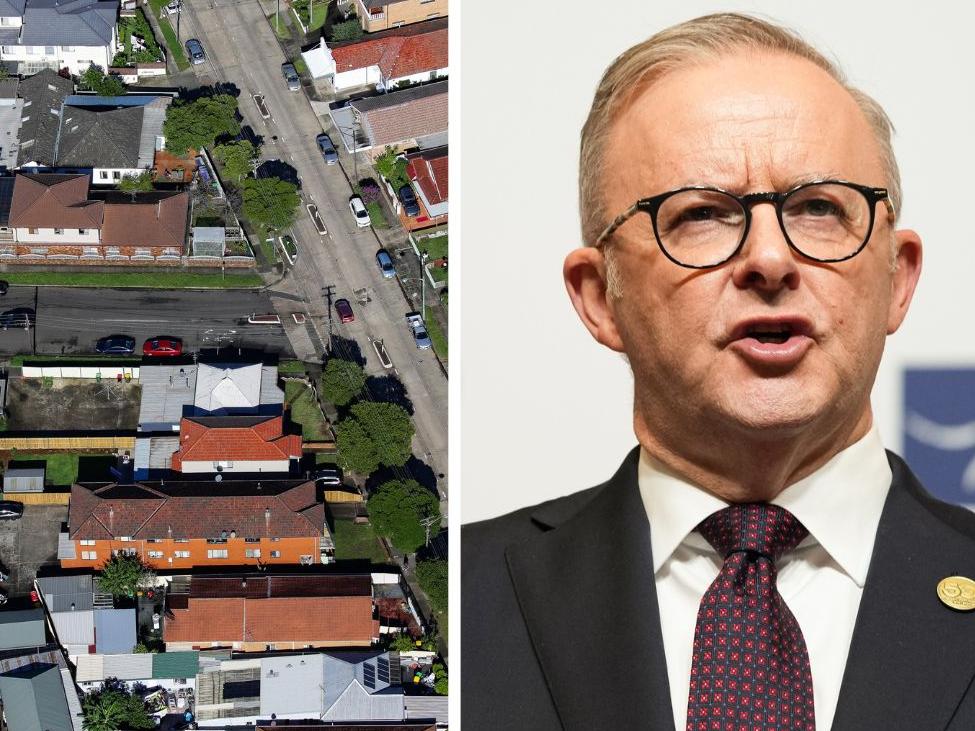There has been a surge in first-home buying since the government expanded the First Home Guarantee in October.
Australia’s housing market has become gripped in a first-home buying frenzy following the federal government’s controversial decision to supercharge its First Home Guarantee scheme last month.
The scheme allows buyers to enter the market with just a 5 per cent deposit and have government “guarantee” the rest of a traditional 20 per cent deposit, helping buyers get into the market faster.
New figures have revealed a 39.2 per cent surge in applications for the scheme since it was expanded in October, pushing first-home buyer spending to levels not seen in years.
The data, from Australia’s largest mortgage aggregator Loan Market Group, revealed the increase in first-home buyers occurred in every major state.
MORE: Bank’s brutal reaction to couple’s loan plea
The First Home Guarantee was a significant policy in Labor’s campaign for re-election earlier this year. Picture: Hilary Wardhaugh/Getty Images
Queensland was the epicentre of the surge, recording a 55.2 per cent jump in average weekly applications over October. This was followed by South Australia, where applications rose by just under 45 per cent.
There was also a rise in NSW and Victoria, both states where first-home buyer activity has been low for years. Both states saw an increase of about 34 per cent.
Loan Market broker Max White said the surge began the moment the government announced in August that it would be fast-tracking its amendments in October.
These amendments included rising the price caps for eligibility (including in Sydney where $1.5m became the cut off for first-home buyers to access the support). Salary caps were removed.
MORE: $120k rise: how much the average Sydney house is now worth
REA Group senior economist Eleanor Creagh said increasing first-home buyer activity has contributed to home price rises.
The scheme allows buyers to enter the market with just a 5 per cent deposit – and some applicants are even eligible for buying with deposits as low as 2 per cent.
Government then acts as guarantor for 15 or 18 per cent of the loan — removing the need for costly lenders mortgage insurance and helping buyers leapfrog years of saving.
“As soon as news came out that the changes to the scheme would be introduced in October rather than next year, first-home buyers reached out to get pre-approved with lenders who participate in the scheme,” Mr White said.
He added that the scheme was helping more buyers land a foot on the property ladder.
“The take-up shows how much first-home buyers were needing more support to break into competitive property markets,” Mr White said.
Renewed first-home buyer spending was partly behind home prices hitting a record peak over October, according to REA Group economist Eleanor Creagh.
Ms Creagh said higher first-home buyer spending coincided with a rise in demand from every other buyer segment – all at a time when listing levels and the construction pipeline remained constrained.
Australian home prices are now up nearly $65,000 from a year ago, PropTrack figures showed.
Agents are also reporting a return of buyer FOMO – not just from those accessing the scheme but other buyers fearful it will drive up prices.
“Everyone is terrified of how much the scheme will increase prices around them and they want to get in before it happens,” said Angus Gorrie, a top Sydney agent at Ray White Eastern Beaches.
Some property experts fear the policy has major drawbacks.
Property expert Darragh Heard of Tallpopie said there were similarities between the scheme and lending practices that led to one of the worst overseas financial disasters.
“Buyers beware,” she said. “There’s an air of the 2007 US market crash about this scheme.
“Access now may mean entrapment long-term. Higher mortgage repayments, greater interest, and what if property value falls. This needs to be regulated to the hilt.”
AMP chief economist Shane Oliver was vocal about his opposition to the scheme while appearing on Mark Bouris’ ‘Property Insights’ podcast.
Price caps for the guarantee scheme were expanded to $1.5m in Sydney over October.
Mr Oliver repeatedly called the scheme “ridiculous”. He argued it was not in the best interest of most first-home buyers.
“If you get in first … then fantastic, you get an advantage,” he said. “But (for) everybody else down the queue, the price just goes up by the same amount (as the price cap increase). It’s ridiculous.”
Mr Oliver said young people using the scheme would have to incur substantially more debt – even if they saved on lender’s mortgage insurance.
He noted that those using the scheme would be lumped with pricier loans and they would borrow 95 per cent of the value of their property purchases.
MORE: Major update: Wilkinson, FitzSimons’ big loss
AMP chief conomist Shane Oliver said aspects of the scheme were “ridiculous”. Picture: John Appleyard
Simon Ma, the head of advisory group Our Top 10, said the scheme would encourage buyers to borrow more, extending the life of their debt.
“Some first-home buyers believe the government is contributing the additional 15 per cent deposit, leaving them with an 80 per cent LVR loan. That’s not how it works,” Mr Ma said.
“Buyers are taking on a 95 per cent LVR loan, borrowing 95 per cent of the property value. The government guarantee simply removes the need for lenders mortgage insurance, it doesn’t reduce the loan size.”

